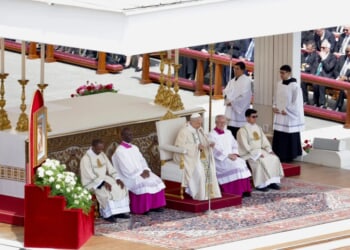SEAL Team Six accidentally crashed a helicopter during the famed 2011 raid. Out of spite for its own humiliation, Pakistan forwarded the wreckage to China—with disastrous results.
Fourteen years ago, one of the most daring raids in modern U.S. military history took place. Most have remembered it fondly as a necessary closure for the Americans who had lived through the terror of the 9/11 attacks. Historians typically agree it was President Barack Obama’s finest hour.
Yet we often view moments like these through rose-tinted glasses. And the Bin Laden raid on May 2, 2011, was one of those moments that had consequences far more significant than the death of the world’s most wanted terrorist. Notably, the raid resulted in the destruction of one of America’s most secretive stealth helicopters—and its remains were quickly handed over to China’s People’s Liberation Army (PLA), which put it to use in building its own.
SEAL Team Six Lost a Helicopter During the Bin Laden Raid
Having tasked the Navy SEALs with flying from Afghanistan into neighboring Pakistan, the American special forces group flew in two previously classified stealth variants of the ubiquitous Sikorsky Black Hawk helicopter. The trip took around 90 minutes.
Once the SEALs got into Pakistan, they had to evade sophisticated radar networks. (Investigative journalist Seymour Hersh argues that the Pakistanis likely turned their radars off, as they were aware the Americans were coming and wanted plausible deniability. Others have rejected this explanation. It matters little today.)
What is clear is that the use of America’s previously-unknown stealth helicopters was key to avoiding Pakistani air defenses. And suitably concealed, the SEALs swiftly arrived at the compound where Osama bin Laden, the mastermind behind the 9/11 terrorist attacks, had holed up. Nestled in a walled compound in Abbottabad, Pakistan—just down the road from the Pakistani military’s version of West Point—the stealthy Black Hawks appeared overhead.
That’s when the first problems occurred. One of the helicopters hovered just above the courtyard at the Abbottabad complex. The experimental stealth helicopter, however, got too close to the high walls. Those walls, along with the unexpectedly high ground temperatures that night, conspired to trigger what’s known in the aviation community as a “vortex ring state” wherein the airflow was disrupted—prompting the Black Hawk’s tail to crash against the wall, rendering it unusable for takeoff.
Fortunately, the SEALs had planned for this redundancy by using two helicopters. Once the mission was complete—and bin Laden’s corpse had been secured—they went about pulling as much of the classified gear from the downed bird as possible, before destroying the body with plastic explosives.
Pakistan Sticks It to America—by Helping China
Unfortunately for the Americans, the destruction of the downed experimental stealth Black Hawk wasn’t total. The tail section—the part damaged in the initial crash—survived. It was extensively photographed and taken into custody by a Pakistani military that had just had its pride grievously wounded. More ominously, out of spite, the Pakistani military allowed for Chinese military scientists to closely inspect the tail section.
The tail section was a modified five-or-six-blade tail rotor, and had distinctive angular features that one would normally find on a stealth aircraft. The U.S. government has never publicly acknowledged the MH-X stealth helicopter program, although it is clear that these helicopters incorporated many lessons learned from developing the canceled RAH-66 Comanche stealth attack helicopter.
This, of course, leads to the larger question: why did Obama and his team believe that it was necessary to humiliate Pakistan, an American ally and partner in the Global War on Terror, by violating its airspace and conducting such a brazen raid?
It was inevitable that bin Laden would be targeted somehow. What we know today, though, is that there was a real dispute within the Obama administration as to how that action should be taken. Notably, then-Vice-President Joe Biden and Secretary of Defense Robert Gates favored simply using a drone to annihilate the compound in the dead of night, thereby minimizing America’s military footprint in the city where Pakistan’s version of West Point was based and avoiding any unintended complications.
But national security decisions do not happen in a vacuum. Obama wanted to make a political show by being the man who got Bin Laden. With the advent of a close 2012 re-election campaign approaching, Obama wanted to open that race by ensuring everyone knew it was his decision that led to the end of America’s greatest enemy. Having a raucous Navy SEAL raid, while riskier, was preferable from a political standpoint than simply dropping some bombs on the compound from a drone.
Now China Has Advanced Helicopters
Today, however, this short-sighted political decision lives with us. Especially since the Chinese People’s Liberation Army (PLA) unveiled what many Western analysts have described as a “clone” of the Black Hawk stealth helicopter, the Z-20 stealth helicopter.
China’s stealthy Z-20 will prove to play a critical role whenever Beijing finally decides to strike hard against neighboring Taiwan. And it seems clear that the Chinese stealth helicopter program was helped along significantly by their access to America’s downed stealth helicopter.
In short, we got bin Laden. But in the process, America handed over one of its most unique weapons to the enemy in its next big war, China.
About the Author: Brandon J. Weichert
Brandon J. Weichert, a Senior National Security Editor at The National Interest as well as a contributor at Popular Mechanics, who consults regularly with various government institutions and private organizations on geopolitical issues. Weichert’s writings have appeared in multiple publications, including the Washington Times, National Review, The American Spectator, MSN, the Asia Times, and countless others. His books include Winning Space: How America Remains a Superpower, Biohacked: China’s Race to Control Life, and The Shadow War: Iran’s Quest for Supremacy. His newest book, A Disaster of Our Own Making: How the West Lost Ukraine is available for purchase wherever books are sold. He can be followed via Twitter @WeTheBrandon.
Image: Wikimedia Commons.

















